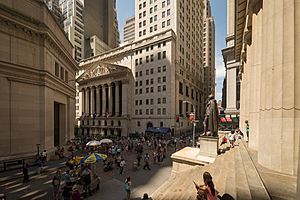Market capitalization facts for kids

Market capitalization, often called market cap, is a way to measure how much a company is worth. It's the total value of all the shares of a company that are owned by people.
You can figure out a company's market cap by multiplying the price of one share by the total number of shares that exist.
Contents
What is Market Cap?
Market cap helps us understand how big a company is. It only looks at the value of a company's shares, not its debt (money it owes). A company might be very big, but if it has a lot of debt, its market cap won't show that.
Market cap is also used to compare the size of different stock exchanges. It's the total value of all the companies listed on that exchange.
Here are some recent total market cap values for all publicly traded companies in the world:
- 2023: US$111 trillion
- 2024: US$126 trillion
- February 2025: US$124 trillion
- Later in 2025: US$159.36 trillion
How to Calculate Market Cap
Calculating market cap is simple! You use this formula:  Here, MC stands for market capitalization. N is the number of shares a company has available. P is the price of one share.
Here, MC stands for market capitalization. N is the number of shares a company has available. P is the price of one share.
Let's say a company has 4 million shares. If each share costs $20, its market cap is $80 million (4 million x $20). If the share price goes up to $21, the market cap becomes $84 million. If it drops to $19, the market cap falls to $76 million.
Different Sizes of Companies
Companies are often grouped by their market cap. This helps investors understand their size. The names for these groups are:
- Mega-cap: These are super huge companies, like Apple or Microsoft. They have a very high market cap, usually over $200 billion.
- Large-cap: These are also very big companies, but not as massive as mega-caps. Their market cap is typically between $10 billion and $200 billion.
- Mid-cap: These are medium-sized companies. Their market cap is usually between $2 billion and $10 billion.
- Small-cap: These are smaller companies. Their market cap is often between $250 million and $2 billion.
- Micro-cap: These are very small companies, with a market cap less than $250 million.
- Nano-cap: These are the smallest companies, sometimes with a market cap less than $50 million.
These numbers can change over time due to things like inflation and how the overall market is doing. So, what's considered "large" today might have been "mega" many years ago!
Images for kids
See also
 In Spanish: Capitalización de mercado para niños
In Spanish: Capitalización de mercado para niños
- List of countries by stock market capitalization
- List of public corporations by market capitalization
- Market price


